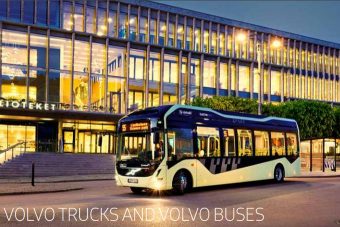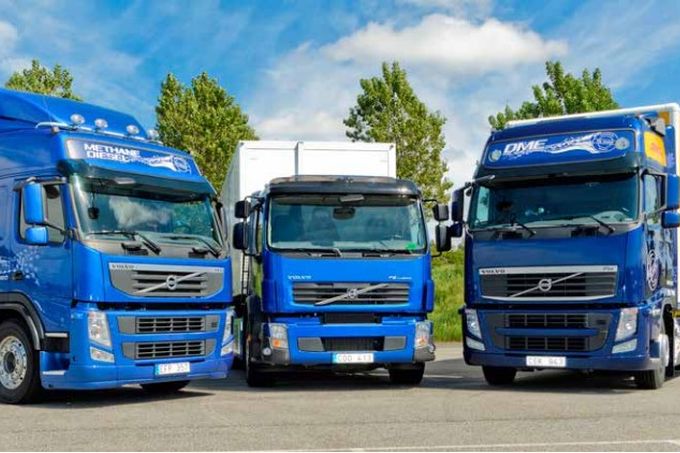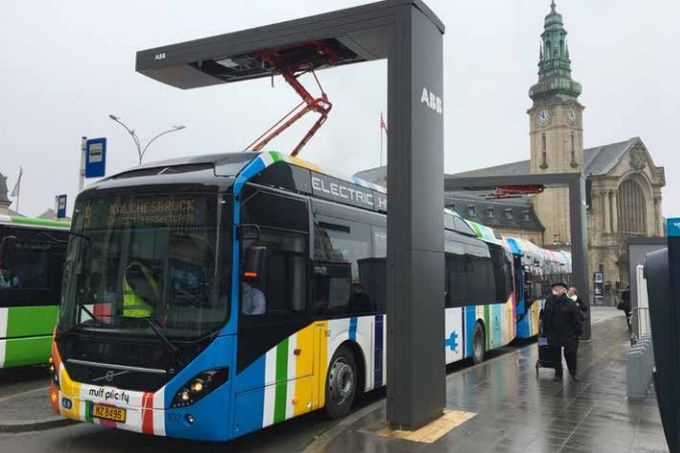
Natural gas, biogas, and electricity accumulated in batteries are just some of the energy sources that the world-famous manufacturer of commercial vehicles uses to replace fossil fuels with increasing success, thus achieving a double effect: reducing exploitation costs, and leaving a far lesser impact on the environment.
As early as the eve of the first energy crisis in the mid-1970s, in Volvo Group they presciently concluded that the cheap crude oil era was coming to an end, that in time there would be less and less of it, and that the “black gold” burning products would increasingly and abundantly pollute the environment. That’s why four decades ago, in the development departments of all members doing business under the Volvo brand, they started conducting extensive experiments with propulsion systems that could replace the “classics” in the foreseeable future – above all, high power diesel engines.
Based on intensive laboratory development and numerous exploitation tests, in Gothenburg, they concluded, much like their competitors, that natural gas (methane) was the most economical, and in terms of the quickest implementation the most apparent replacement for diesel. Apart from the large quantities (according to unconfirmed research, the world reserves are enough for the current consumption for a period longer than 400 years), the fact that it is several times cheaper than other fossil fuels, and that the infrastructure for using it is more and more developed and geographically widespread, one of the most important advantages is that the products of its combustion have little effect on the environment.
With such “features”, natural gas in compressed or liquid state is a very good alternative fuel that Volvo recommends for the operation of city buses, and more recently, for the operation of distribution-utility trucks. For example, in the latest generation of medium-sized FE trucks, primarily designed for regional and local transport, Volvo Trucks, in addition to the most modern diesel engines, also installs a 320 horsepower aggregate that burns compressed natural gas.
The “gas” engine emits such a small amount of solid particles that it does not even need a soot filter. This means that no other exhaust gas cleaning systems are required, nor any other auxiliary agents, such as the AdBlue agent. When using bio-gas, the Volvo FE CNG emits as much as 70 percent less carbon dioxide in the atmosphere (CO2) compared to the same truck with a conventional diesel engine. The customers are offered the option of installing eight or six tanks for compressed gas on the “gas” truck chassis, which allows working autonomy of up to 400 km in light distribution of goods, and up to 250 km in the difficult collection of municipal waste. According to the load features and standard equipment, the natural gas truck is practically identical to the “twin” that burns diesel, but with significant advantages – it is more economical and eco-friendly than a typical “oiler”.

According to estimates by Volvo Trucks’ development experts, natural gas has great chance as “supplement” fuel as well, which will make conventional diesel engines more economical, but above all ecologically “more suitable”, which means less polluting. For over ten years, Volvo has been experimenting with systems that inject up to 25 percent liquid methane or biogas in conventional diesel engines. When a specially adapted diesel engine burns liquid methane, carbon dioxide emission is reduced by 10 percent, and when biogas is used as a supplementary energy source, this reduction can be as high as 70 percent.
Volvo Trucks also has high expectations from biogas, which can be obtained not only from biodegradable waste (plant mass-forest residues, fruit and vegetable residues in the food preparation process, manure), but also from byproducts of some industrial plants. For example, to move a single version of a solo truck from its heaviest family, FH, Volvo used biogas produced from black liquor, which was a by-product created in the paper pulp production process. Based on Volvo’s experience, and experience of experts from other companies dealing with similar research, the European Union’s supreme authorities estimate that by 2030, bio-DME (dimethyl ether, C2 H6 O) could replace as much as half of diesel fuel currently used for road freight transport!
And while engines that burn natural gas are offered by the majority of competitors, and many experiment with other alternative fuels, the Volvo truck division is a leader in development, and the bus division is a leader in the production of hybrid, diesel/electric vehicles. In 1995, on the streets of Gothenburg, the “hometown” of Volvo cars and commercial vehicles, the first prototypes of electrical and diesel trucks and buses saw the light of day, and they were original in terms of their shape, and even more unusual in terms of the engine. Over the next 12 years, the hybrid drive technology was so perfected that in 2007, Volvo could already offer trucks and buses manufactured in preproduction with a combined drive group – an electric and diesel engine.
The humble, rational and ecologically very conscious Swedes estimate that the development of hybrid propulsion trucks has not yet reached the level of large-scale application, and in the past ten years in Gothenburg they have diligently improved the hybrid “technique” built into trucks for distribution and communal activities – above all garbage collection and disposal. They continued to bring them onto the production lines at full speed, and at the same time they experimented with a hybrid drive on the heaviest, and in terms of the extent of production and sales the most widespread Volvo trucks for long-distance transport, specifically the FH family.
In May 2016, the first version of a concept truck was presented, and in late February 2017, the second further improved version was presented as well. In addition to improved aerodynamics, reduced rolling resistance and lower mass, the new version also had a hybrid drive – one of the first of its kind built into heavy “road cruisers” for long-distance, international transport.
Based on road trials, Volvo experts estimate that in long-haul transport, a hybrid drive could enable diesel and other internal combustion engines to shutdown up to 30% of the time while driving. This can save 5 to10 percent of the fuel, depending on the type or specification of the vehicle, mass, driving cycle and topography. Advanced solutions on the concept tractor provide the option of driving in a fully electric mode – up to 10 km, when there is practically no pollution, and the whole transport combination (towing + towing vehicle) emits a low noise level.
The hybrid technology built into the concept tractor allows recovery of electricity when driving downhill – on inclines greater than 1% or when braking. The resulting current is sent to the batteries and is used to drive the truck in a fully electric mode – on flat roads or roads with small inclines. The advanced version of the drive system predictable engagement – I-See, which has been developed by Volvo Trucks (and is already being built into the heaviest FH family), is additionally adapted to hybrid drive circuits, and by analyzing the topography of the upcoming terrain, it precisely determines the most economical and efficient engagement of diesel and electric engines, as well as optimum renewed energy exploitation time. Combined with other improvements in conventional versions, the most impressive effect of the still experimental hybrid technology for heavy trucks is a total reduction in fuel consumption and CO2 emission by about 30 percent.
Also, these are great energy and ecological results already being achieved by other large-scale vehicles with a Volvo mark – city buses! With nearly 4,300 “electrified” buses sold from production in Europe and from the North American daughter company Nova Bus, Volvo Buses is the absolute world leader in this field! Volvo launched the first serially manufactured buses with a hybrid drive system in 2010. Year after year, the range of vehicles with alternative drive solutions has continually increased and sold, so today Volvo Buses offers comprehensive system solutions for public transport with a combined or fully electric drive – diesel-electric hybrid buses, electric hybrids and fully electric buses. Diesel-electric hybrids are available in a conventional 12-meter configuration, as articulated buses, and also as double-deckers.
And finally, at least partly, let’s demystify one of the currently most promising alternative technologies for driving Volvo’s public transport buses (and also Volvo trucks): the “green” buses in Čačak (as well as on the streets of numerous cities in 22 countries around the world) are driven by a parallel hybrid drive system developed and manufactured by Volvo. They are comprised of an Euro V four-cylinder diesel engine with a Volvo working volume of 4.76 liters with 215 hp and 800 Nm of maximum torque, and a 120 kW electric engine with the same maximum torque of 800 Nm. The rear wheel drive is carried out by the Volvo I-SAM system, which includes an automated I-Shift 12-gear trans-mission. The entire drive group is mounted on the line in the left rear part of the chassis (similar to conventional diesel-powered buses). The lithium-ion battery “pack” is mounted right behind the front left wheel. This drive group is equipped with a Stop-Start system, which, when the batteries are fully charged, turns off all the engines while the vehicle is idle, which further reduces the consumption and emission of exhaust gases. The Volvo hybrid bus starts moving almost silently, given that the starting-off of the vehicle is powered by an electric engine running only on electricity. When the vehicle reaches a speed of 15 to 20 km/h, it turns on and also occasionally turns off a conventional diesel engine, which has the role to recharge lithium-ion batteries that accumulate electricity to drive the electric engine. Electricity is accumulating every time a driver of a Volvo hybrid bus hits the brakes. That is where, among other above “places”, all the Volvo hybrid “magic” lies.

Since early April, Volvo hybrid drive technology has been “ridding” in Serbia: Čačak is the first town in our country, in the Balkans, and also in the wider region where 10 Volvo buses with the most advanced technology are used for local passenger transport with a combined diesel-electric drive. In the first days of exploitation, they already confirmed the factory declared parameters: their consumption is lower by a third compared to the diesel engines, and the emission of harmful gases is smaller in similar proportions. “On one of the busiest lines, the 18-kilometer long Sloboda-Slatina line, which transports between three and five thousand passengers per day, the Volvo 7705 LH Hybrid bus has demonstrated all the advantages of a hybrid drive compared to conventional diesel engine powered vehicles: our drivers have achieved an average fuel consumption of 29 liters per 100 km with them, while the consumption of buses of similar transport features with a conventional diesel engine is about 45 liters per 100 km”, says Marko Živković, the main dispatcher of urban and suburban traffic in Autoprevoz- Čačak. “But for our residents, it is of greater importance that the emission of harmful exhaust gases is reduced in a similar proportion, i.e. by a third. Our hybrid “firstborns” produce far less noise, not just when starting off, but also during a continuous drive,” adds Mr. Živković.
This content was originally published in the eighth issue of the Energy Portal Bulletin, named ECOMOBILITY

